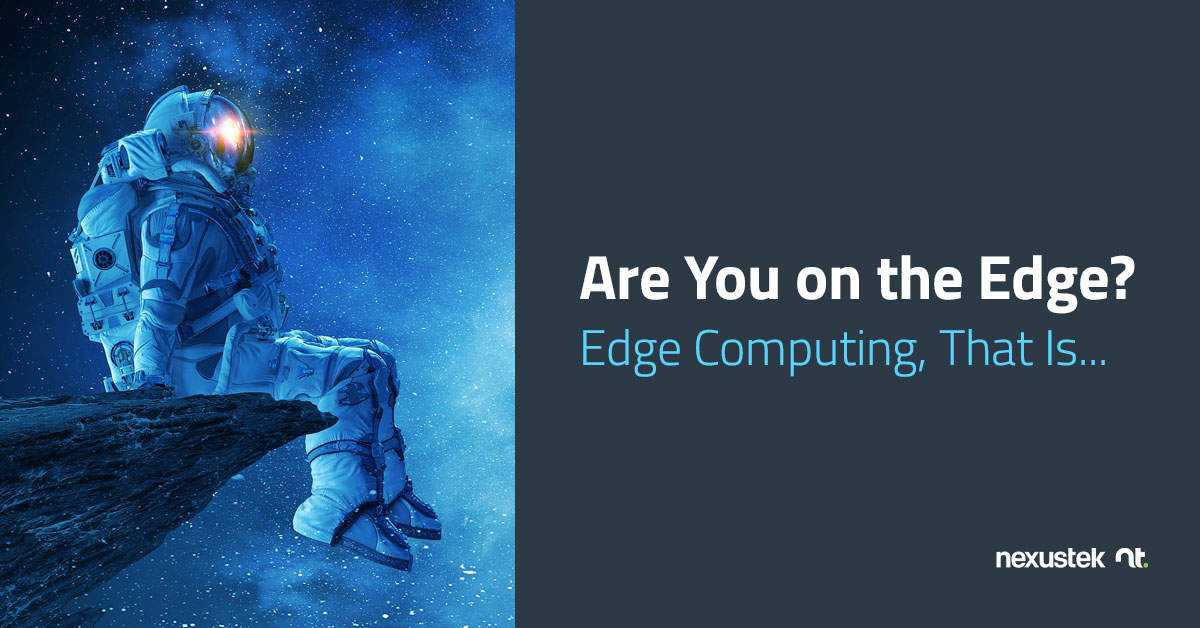READ TIME: 4 MIN

Are You on the Edge? Edge Computing, That Is…
As the next “big thing” in technology, edge computing has created a buzz that is exciting but not always easy to decipher. Is edge computing just a fancy name for the Internet of Things (IoT)? Will edge computing replace the cloud? How do I prepare my business for edge computing? These are all relevant questions for business leaders to consider, so let’s start with a straightforward description of how edge computing works.
What Is Edge Computing?
Although IoT devices are currently the most common application of edge computing, the two are not synonymous. Edge computing is similar to cloud computing, with a major difference being the distance between (a) where the data is created, and (b) where the data is processed. Usually, “where the data is created” equates to an endpoint, like a laptop or IoT device.
With cloud computing, the data you or your device creates might be processed in a cloud center two states away. With edge computing, however, that data will be processed in a location that is much closer to you or your device. Edge computing relies upon micro data centers that are more widely dispersed than cloud centers, as proximity to endpoints is central to its functionality.
Why Is Everyone So Excited About Edge Computing?
Although it is still in its nascent stages, edge computing is already used in some form by 38% of small and medium-sized businesses—and this proportion is expected to rise sharply over coming years1. The excitement swirling around edge computing is largely about its speed, and what its speed makes possible.
Because data travels a shorter distance with edge computing compared to cloud, the processed data is returned to the end user or device much more quickly. Although you might not notice this speed difference if you’re, say, creating a report in Excel using existing data, you might observe lags or delays (i.e., latency) for tasks that involve processing a higher volume of data, such as reviewing a dashboard that is fed by real-time data, or streaming video content.
Strategic IT Planning and Edge Computing
For purposes of strategic IT planning for your business, it is important to understand that edge computing is not expected to replace cloud computing. However, Gartner predicts that 75% of business data will be processed at the edge by 2025, a steep increase from 10% in 20182. Edge computing is expected to augment the cloud in an increasingly prominent way, with each type of computing occupying its own specific role.
Integrating edge computing into your IT strategy will require that you determine where it is needed to drive business outcomes and where it is not:
- Real-time data processing: When real-time data processing is required for staying on top of sensitive processes or outcomes (e.g., medical or factory sensor monitoring), edge computing is the optimal choice.
- Enhancing customer experience: When being faster makes a difference in customer experience, edge computing can give you the advantage. Keep in mind that even milliseconds matter in the customer experience. To illustrate, a 2020 study of mobile website performance across 37 brands found that an increase in speed of just 100 milliseconds was associated with an 8.4% increase in retail conversion rates3.
Edge Computing and Cyber Security
With the introduction of any new technology that is accessible via the internet, cyber security concerns should be front and center. Edge computing as a process is tightly intertwined with the devices that supply the data, such as factory sensors, actuators, mobile phones, and autonomous vehicles. Incorporating edge computing into your IT landscape will likely bring an explosion in the number of endpoints.
This has implications for cyber security because each endpoint creates an additional point of entry for hackers. The proliferation of IoT devices has not gone unnoticed by cyber criminals, who increasingly target these devices. At the same time, 48% of businesses that use IoT devices have no processes in place for detecting whether such devices have been hacked4. Having a solid cyber security plan, both preventive and responsive, is essential for businesses as they move into edge computing.
Integration of edge computing into your IT strategy requires careful planning and preparation. NexusTek can assist with strategic IT assessments, cyber security solutions, and ongoing managed IT to maintain optimal functionality of your edge computing infrastructure.
Would you like to learn more about optimizing your IT strategy?
References:
- Research and Markets. (2021, November 30). Global edge computing markets 2021-2026: Rising use of BYOD in modern business and technological evolution to drive the market growth. GlobalNewswire. https://www.globenewswire.com/news-release/2021/11/30/2342704/28124/en/Global-Edge-Computing-Markets-2021-2026-Rising-Use-of-BYOD-in-Modern-Business-and-Technological-Evolution-to-Drive-the-Market-Growth.html
- (2018, October 3). What edge computing means for infrastructure and operations leaders. https://www.gartner.com/smarterwithgartner/what-edge-computing-means-for-infrastructure-and-operations-leaders
- (2020). Milliseconds make millions. https://www2.deloitte.com/ie/en/pages/consulting/articles/milliseconds-make-millions.html
- Schwab, K. (2019, January 16). IoT security is so bad, many companies can’t tell when they’re hacked. Fast Company. https://www.fastcompany.com/90292568/iot-security-is-so-bad-many-companies-cant-tell-when-theyre-hacked